Why Lehman Brothers Filled for Bankruptcy in 2008
VerifiedAdded on 2021/11/16
|8
|2482
|65
AI Summary
Critically assess the extent to which market failure and behavioural bias theory can explain bank failures during the 2008 financial crisis, referring to evidence from banks of at least one bank failure during that financial crisis. Under the theoretical model the rational choice model will further explain what is expected in financial markets in over and under-pricing, bank regulations and justifications, and also the nature of heuristics actions and their consequences. Background information One of the main banking functions is maturity transformations that help it to finance long
Contribute Materials
Your contribution can guide someone’s learning journey. Share your
documents today.
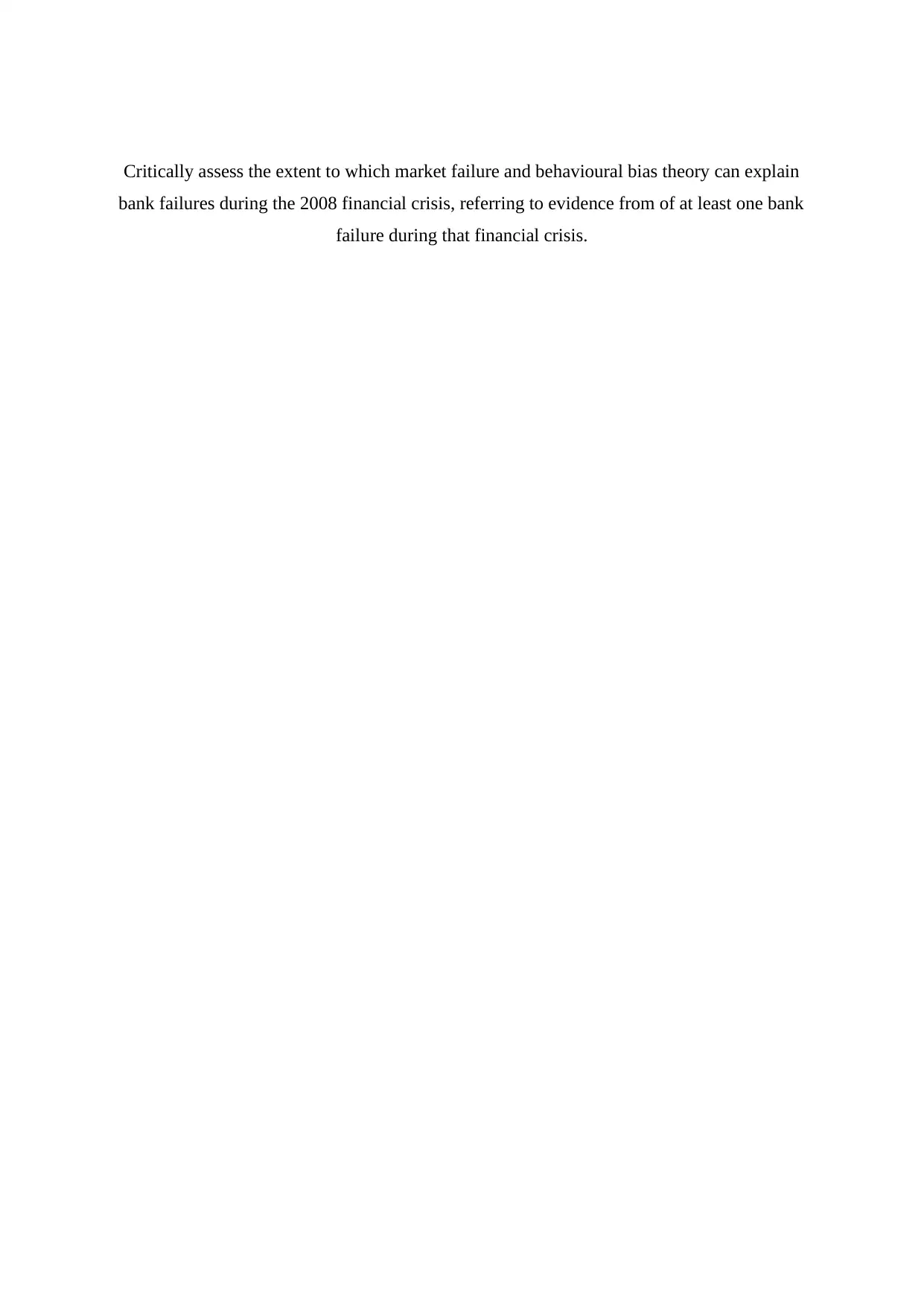
Critically assess the extent to which market failure and behavioural bias theory can explain
bank failures during the 2008 financial crisis, referring to evidence from of at least one bank
failure during that financial crisis.
bank failures during the 2008 financial crisis, referring to evidence from of at least one bank
failure during that financial crisis.
Secure Best Marks with AI Grader
Need help grading? Try our AI Grader for instant feedback on your assignments.
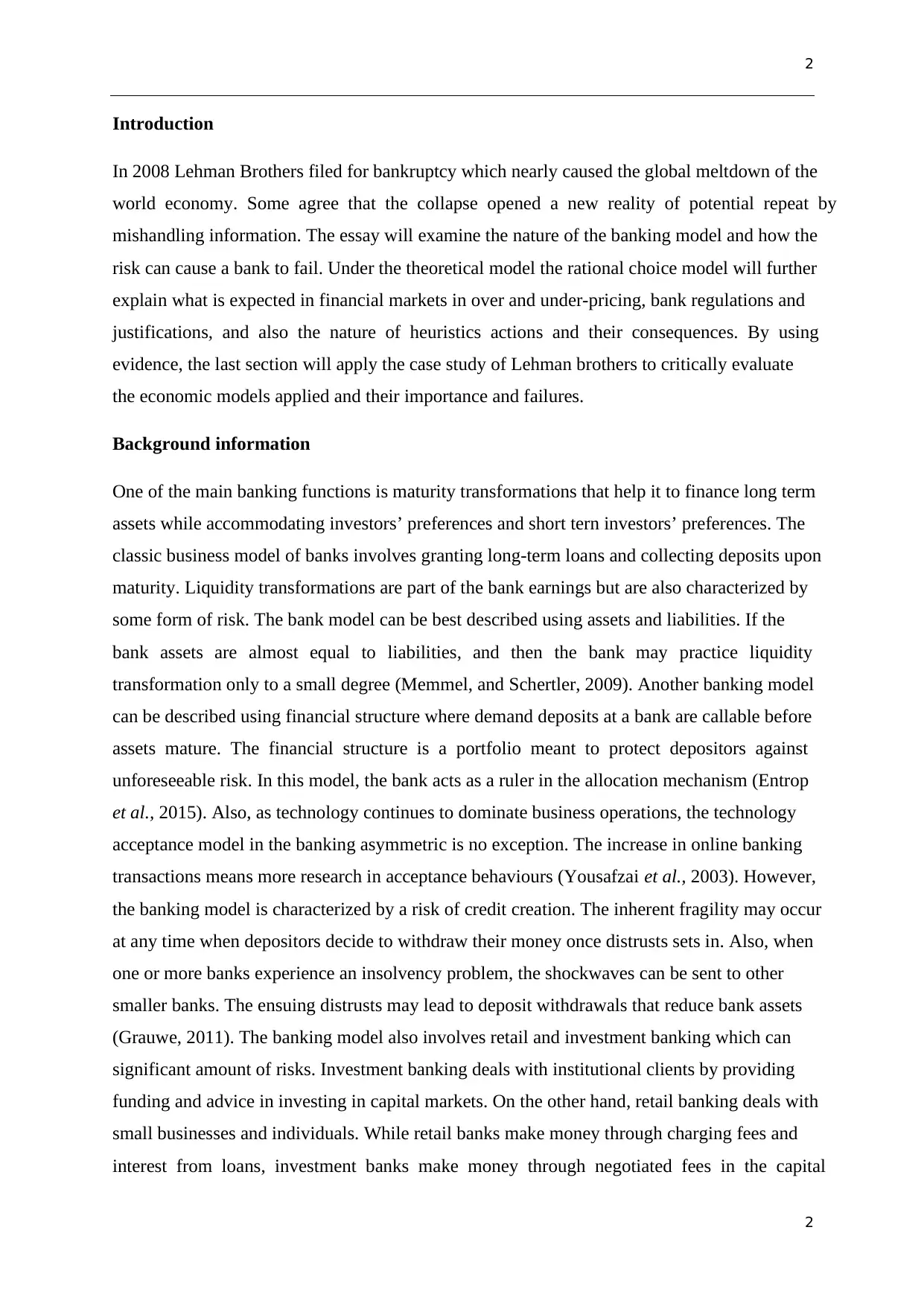
2
2
Introduction
In 2008 Lehman Brothers filed for bankruptcy which nearly caused the global meltdown of the
world economy. Some agree that the collapse opened a new reality of potential repeat by
mishandling information. The essay will examine the nature of the banking model and how the
risk can cause a bank to fail. Under the theoretical model the rational choice model will further
explain what is expected in financial markets in over and under-pricing, bank regulations and
justifications, and also the nature of heuristics actions and their consequences. By using
evidence, the last section will apply the case study of Lehman brothers to critically evaluate
the economic models applied and their importance and failures.
Background information
One of the main banking functions is maturity transformations that help it to finance long term
assets while accommodating investors’ preferences and short tern investors’ preferences. The
classic business model of banks involves granting long-term loans and collecting deposits upon
maturity. Liquidity transformations are part of the bank earnings but are also characterized by
some form of risk. The bank model can be best described using assets and liabilities. If the
bank assets are almost equal to liabilities, and then the bank may practice liquidity
transformation only to a small degree (Memmel, and Schertler, 2009). Another banking model
can be described using financial structure where demand deposits at a bank are callable before
assets mature. The financial structure is a portfolio meant to protect depositors against
unforeseeable risk. In this model, the bank acts as a ruler in the allocation mechanism (Entrop
et al., 2015). Also, as technology continues to dominate business operations, the technology
acceptance model in the banking asymmetric is no exception. The increase in online banking
transactions means more research in acceptance behaviours (Yousafzai et al., 2003). However,
the banking model is characterized by a risk of credit creation. The inherent fragility may occur
at any time when depositors decide to withdraw their money once distrusts sets in. Also, when
one or more banks experience an insolvency problem, the shockwaves can be sent to other
smaller banks. The ensuing distrusts may lead to deposit withdrawals that reduce bank assets
(Grauwe, 2011). The banking model also involves retail and investment banking which can
significant amount of risks. Investment banking deals with institutional clients by providing
funding and advice in investing in capital markets. On the other hand, retail banking deals with
small businesses and individuals. While retail banks make money through charging fees and
interest from loans, investment banks make money through negotiated fees in the capital
2
Introduction
In 2008 Lehman Brothers filed for bankruptcy which nearly caused the global meltdown of the
world economy. Some agree that the collapse opened a new reality of potential repeat by
mishandling information. The essay will examine the nature of the banking model and how the
risk can cause a bank to fail. Under the theoretical model the rational choice model will further
explain what is expected in financial markets in over and under-pricing, bank regulations and
justifications, and also the nature of heuristics actions and their consequences. By using
evidence, the last section will apply the case study of Lehman brothers to critically evaluate
the economic models applied and their importance and failures.
Background information
One of the main banking functions is maturity transformations that help it to finance long term
assets while accommodating investors’ preferences and short tern investors’ preferences. The
classic business model of banks involves granting long-term loans and collecting deposits upon
maturity. Liquidity transformations are part of the bank earnings but are also characterized by
some form of risk. The bank model can be best described using assets and liabilities. If the
bank assets are almost equal to liabilities, and then the bank may practice liquidity
transformation only to a small degree (Memmel, and Schertler, 2009). Another banking model
can be described using financial structure where demand deposits at a bank are callable before
assets mature. The financial structure is a portfolio meant to protect depositors against
unforeseeable risk. In this model, the bank acts as a ruler in the allocation mechanism (Entrop
et al., 2015). Also, as technology continues to dominate business operations, the technology
acceptance model in the banking asymmetric is no exception. The increase in online banking
transactions means more research in acceptance behaviours (Yousafzai et al., 2003). However,
the banking model is characterized by a risk of credit creation. The inherent fragility may occur
at any time when depositors decide to withdraw their money once distrusts sets in. Also, when
one or more banks experience an insolvency problem, the shockwaves can be sent to other
smaller banks. The ensuing distrusts may lead to deposit withdrawals that reduce bank assets
(Grauwe, 2011). The banking model also involves retail and investment banking which can
significant amount of risks. Investment banking deals with institutional clients by providing
funding and advice in investing in capital markets. On the other hand, retail banking deals with
small businesses and individuals. While retail banks make money through charging fees and
interest from loans, investment banks make money through negotiated fees in the capital
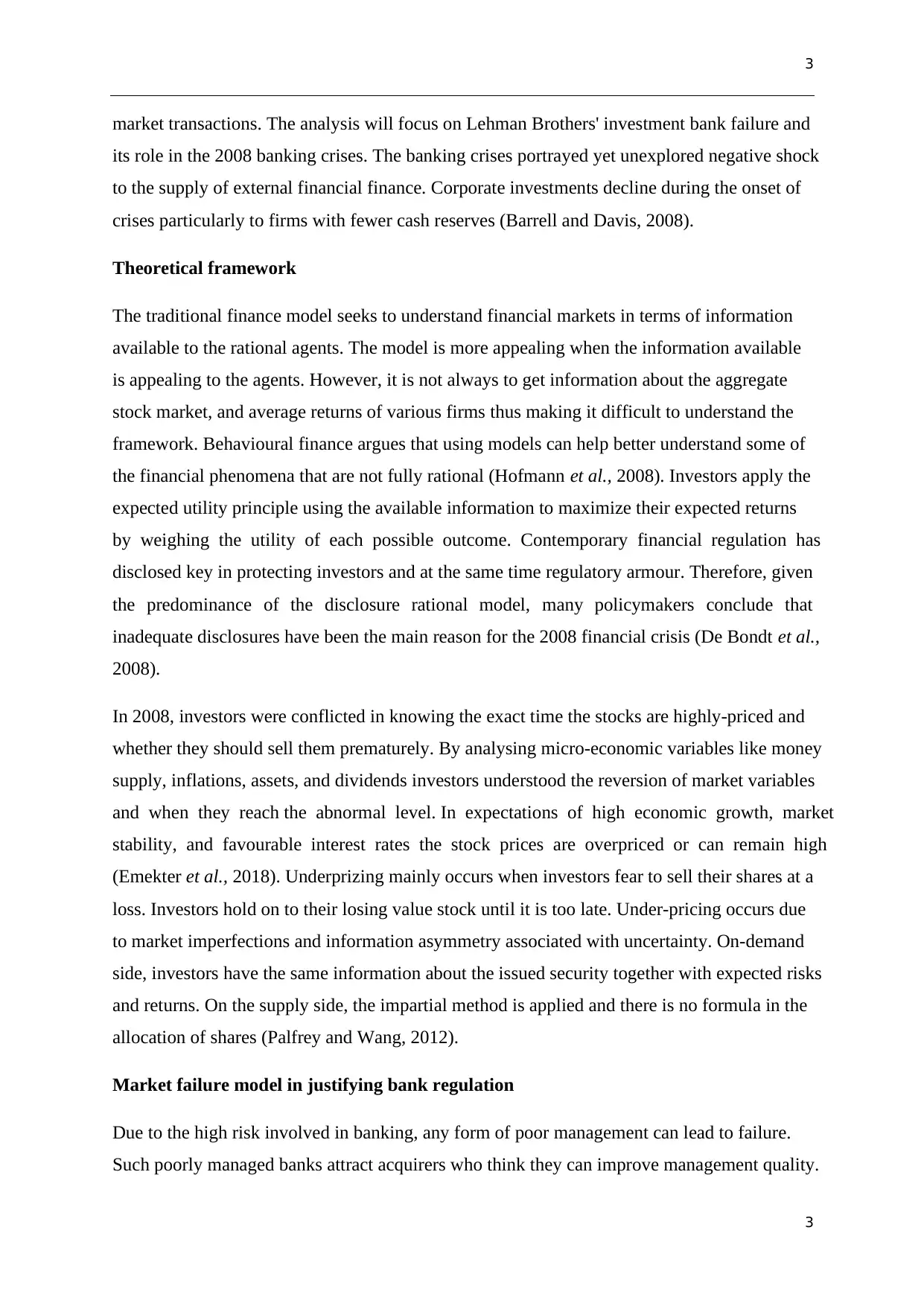
3
3
market transactions. The analysis will focus on Lehman Brothers' investment bank failure and
its role in the 2008 banking crises. The banking crises portrayed yet unexplored negative shock
to the supply of external financial finance. Corporate investments decline during the onset of
crises particularly to firms with fewer cash reserves (Barrell and Davis, 2008).
Theoretical framework
The traditional finance model seeks to understand financial markets in terms of information
available to the rational agents. The model is more appealing when the information available
is appealing to the agents. However, it is not always to get information about the aggregate
stock market, and average returns of various firms thus making it difficult to understand the
framework. Behavioural finance argues that using models can help better understand some of
the financial phenomena that are not fully rational (Hofmann et al., 2008). Investors apply the
expected utility principle using the available information to maximize their expected returns
by weighing the utility of each possible outcome. Contemporary financial regulation has
disclosed key in protecting investors and at the same time regulatory armour. Therefore, given
the predominance of the disclosure rational model, many policymakers conclude that
inadequate disclosures have been the main reason for the 2008 financial crisis (De Bondt et al.,
2008).
In 2008, investors were conflicted in knowing the exact time the stocks are highly-priced and
whether they should sell them prematurely. By analysing micro-economic variables like money
supply, inflations, assets, and dividends investors understood the reversion of market variables
and when they reach the abnormal level. In expectations of high economic growth, market
stability, and favourable interest rates the stock prices are overpriced or can remain high
(Emekter et al., 2018). Underprizing mainly occurs when investors fear to sell their shares at a
loss. Investors hold on to their losing value stock until it is too late. Under-pricing occurs due
to market imperfections and information asymmetry associated with uncertainty. On-demand
side, investors have the same information about the issued security together with expected risks
and returns. On the supply side, the impartial method is applied and there is no formula in the
allocation of shares (Palfrey and Wang, 2012).
Market failure model in justifying bank regulation
Due to the high risk involved in banking, any form of poor management can lead to failure.
Such poorly managed banks attract acquirers who think they can improve management quality.
3
market transactions. The analysis will focus on Lehman Brothers' investment bank failure and
its role in the 2008 banking crises. The banking crises portrayed yet unexplored negative shock
to the supply of external financial finance. Corporate investments decline during the onset of
crises particularly to firms with fewer cash reserves (Barrell and Davis, 2008).
Theoretical framework
The traditional finance model seeks to understand financial markets in terms of information
available to the rational agents. The model is more appealing when the information available
is appealing to the agents. However, it is not always to get information about the aggregate
stock market, and average returns of various firms thus making it difficult to understand the
framework. Behavioural finance argues that using models can help better understand some of
the financial phenomena that are not fully rational (Hofmann et al., 2008). Investors apply the
expected utility principle using the available information to maximize their expected returns
by weighing the utility of each possible outcome. Contemporary financial regulation has
disclosed key in protecting investors and at the same time regulatory armour. Therefore, given
the predominance of the disclosure rational model, many policymakers conclude that
inadequate disclosures have been the main reason for the 2008 financial crisis (De Bondt et al.,
2008).
In 2008, investors were conflicted in knowing the exact time the stocks are highly-priced and
whether they should sell them prematurely. By analysing micro-economic variables like money
supply, inflations, assets, and dividends investors understood the reversion of market variables
and when they reach the abnormal level. In expectations of high economic growth, market
stability, and favourable interest rates the stock prices are overpriced or can remain high
(Emekter et al., 2018). Underprizing mainly occurs when investors fear to sell their shares at a
loss. Investors hold on to their losing value stock until it is too late. Under-pricing occurs due
to market imperfections and information asymmetry associated with uncertainty. On-demand
side, investors have the same information about the issued security together with expected risks
and returns. On the supply side, the impartial method is applied and there is no formula in the
allocation of shares (Palfrey and Wang, 2012).
Market failure model in justifying bank regulation
Due to the high risk involved in banking, any form of poor management can lead to failure.
Such poorly managed banks attract acquirers who think they can improve management quality.
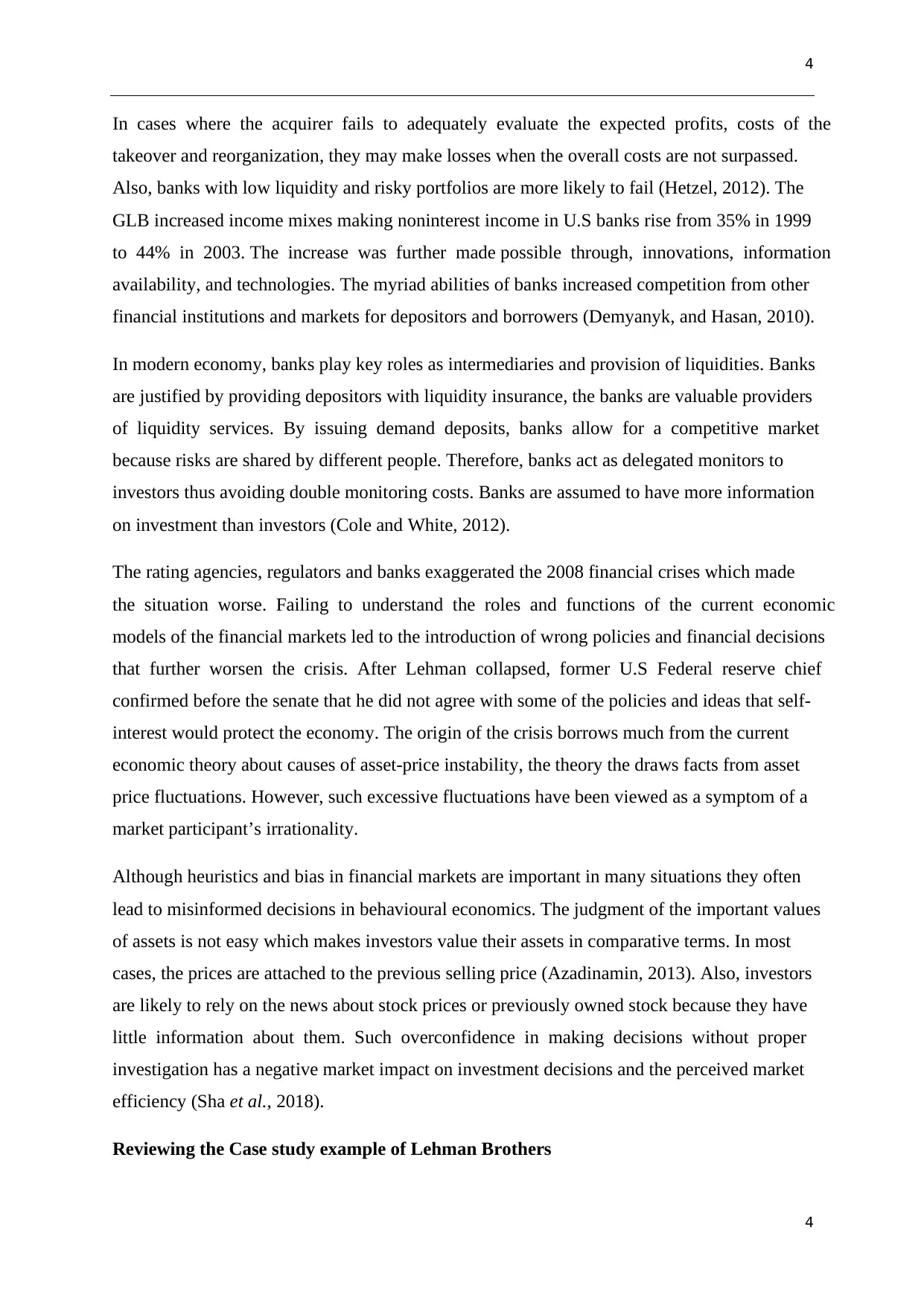
4
4
In cases where the acquirer fails to adequately evaluate the expected profits, costs of the
takeover and reorganization, they may make losses when the overall costs are not surpassed.
Also, banks with low liquidity and risky portfolios are more likely to fail (Hetzel, 2012). The
GLB increased income mixes making noninterest income in U.S banks rise from 35% in 1999
to 44% in 2003. The increase was further made possible through, innovations, information
availability, and technologies. The myriad abilities of banks increased competition from other
financial institutions and markets for depositors and borrowers (Demyanyk, and Hasan, 2010).
In modern economy, banks play key roles as intermediaries and provision of liquidities. Banks
are justified by providing depositors with liquidity insurance, the banks are valuable providers
of liquidity services. By issuing demand deposits, banks allow for a competitive market
because risks are shared by different people. Therefore, banks act as delegated monitors to
investors thus avoiding double monitoring costs. Banks are assumed to have more information
on investment than investors (Cole and White, 2012).
The rating agencies, regulators and banks exaggerated the 2008 financial crises which made
the situation worse. Failing to understand the roles and functions of the current economic
models of the financial markets led to the introduction of wrong policies and financial decisions
that further worsen the crisis. After Lehman collapsed, former U.S Federal reserve chief
confirmed before the senate that he did not agree with some of the policies and ideas that self-
interest would protect the economy. The origin of the crisis borrows much from the current
economic theory about causes of asset-price instability, the theory the draws facts from asset
price fluctuations. However, such excessive fluctuations have been viewed as a symptom of a
market participant’s irrationality.
Although heuristics and bias in financial markets are important in many situations they often
lead to misinformed decisions in behavioural economics. The judgment of the important values
of assets is not easy which makes investors value their assets in comparative terms. In most
cases, the prices are attached to the previous selling price (Azadinamin, 2013). Also, investors
are likely to rely on the news about stock prices or previously owned stock because they have
little information about them. Such overconfidence in making decisions without proper
investigation has a negative market impact on investment decisions and the perceived market
efficiency (Sha et al., 2018).
Reviewing the Case study example of Lehman Brothers
4
In cases where the acquirer fails to adequately evaluate the expected profits, costs of the
takeover and reorganization, they may make losses when the overall costs are not surpassed.
Also, banks with low liquidity and risky portfolios are more likely to fail (Hetzel, 2012). The
GLB increased income mixes making noninterest income in U.S banks rise from 35% in 1999
to 44% in 2003. The increase was further made possible through, innovations, information
availability, and technologies. The myriad abilities of banks increased competition from other
financial institutions and markets for depositors and borrowers (Demyanyk, and Hasan, 2010).
In modern economy, banks play key roles as intermediaries and provision of liquidities. Banks
are justified by providing depositors with liquidity insurance, the banks are valuable providers
of liquidity services. By issuing demand deposits, banks allow for a competitive market
because risks are shared by different people. Therefore, banks act as delegated monitors to
investors thus avoiding double monitoring costs. Banks are assumed to have more information
on investment than investors (Cole and White, 2012).
The rating agencies, regulators and banks exaggerated the 2008 financial crises which made
the situation worse. Failing to understand the roles and functions of the current economic
models of the financial markets led to the introduction of wrong policies and financial decisions
that further worsen the crisis. After Lehman collapsed, former U.S Federal reserve chief
confirmed before the senate that he did not agree with some of the policies and ideas that self-
interest would protect the economy. The origin of the crisis borrows much from the current
economic theory about causes of asset-price instability, the theory the draws facts from asset
price fluctuations. However, such excessive fluctuations have been viewed as a symptom of a
market participant’s irrationality.
Although heuristics and bias in financial markets are important in many situations they often
lead to misinformed decisions in behavioural economics. The judgment of the important values
of assets is not easy which makes investors value their assets in comparative terms. In most
cases, the prices are attached to the previous selling price (Azadinamin, 2013). Also, investors
are likely to rely on the news about stock prices or previously owned stock because they have
little information about them. Such overconfidence in making decisions without proper
investigation has a negative market impact on investment decisions and the perceived market
efficiency (Sha et al., 2018).
Reviewing the Case study example of Lehman Brothers
Secure Best Marks with AI Grader
Need help grading? Try our AI Grader for instant feedback on your assignments.
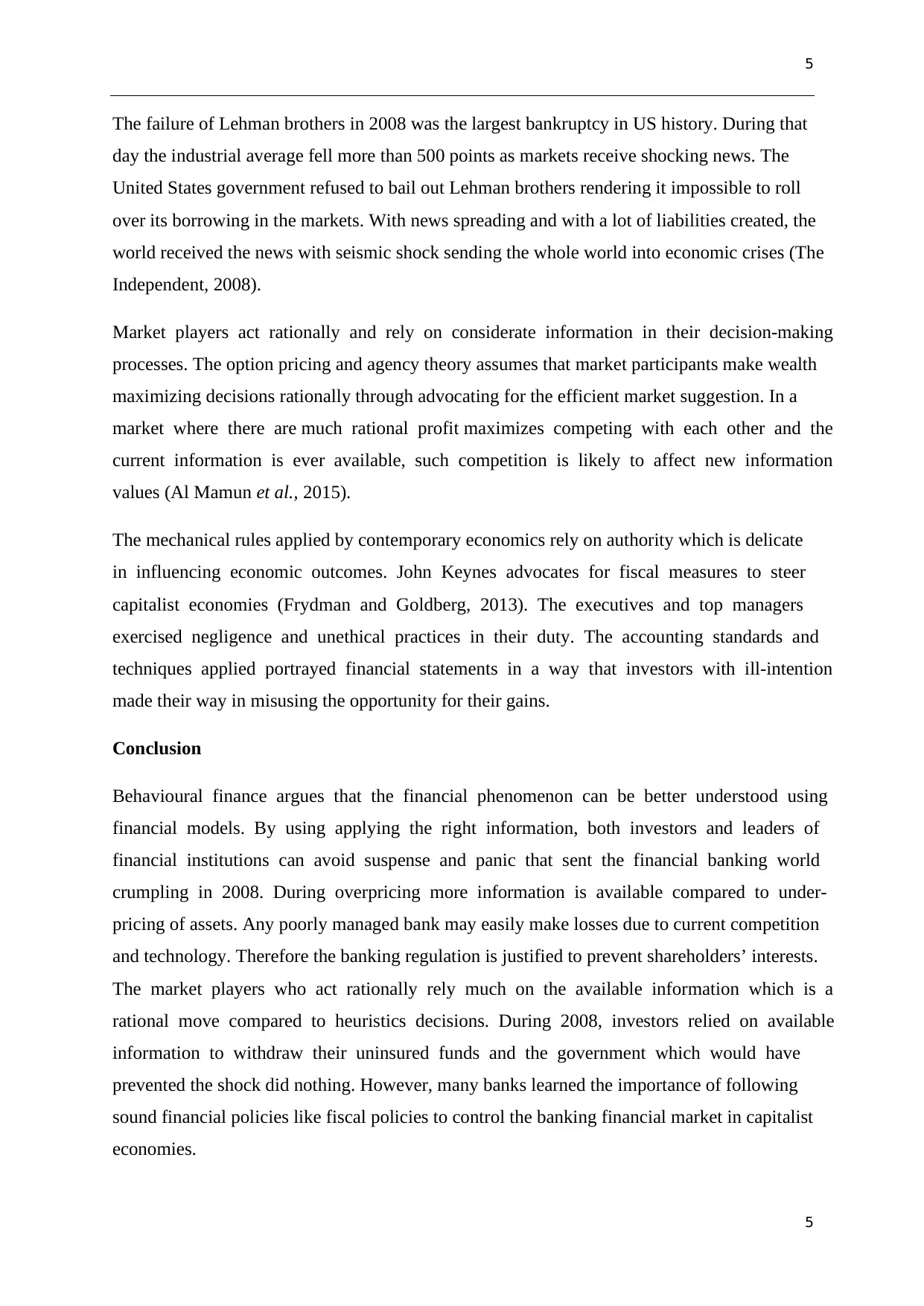
5
5
The failure of Lehman brothers in 2008 was the largest bankruptcy in US history. During that
day the industrial average fell more than 500 points as markets receive shocking news. The
United States government refused to bail out Lehman brothers rendering it impossible to roll
over its borrowing in the markets. With news spreading and with a lot of liabilities created, the
world received the news with seismic shock sending the whole world into economic crises (The
Independent, 2008).
Market players act rationally and rely on considerate information in their decision-making
processes. The option pricing and agency theory assumes that market participants make wealth
maximizing decisions rationally through advocating for the efficient market suggestion. In a
market where there are much rational profit maximizes competing with each other and the
current information is ever available, such competition is likely to affect new information
values (Al Mamun et al., 2015).
The mechanical rules applied by contemporary economics rely on authority which is delicate
in influencing economic outcomes. John Keynes advocates for fiscal measures to steer
capitalist economies (Frydman and Goldberg, 2013). The executives and top managers
exercised negligence and unethical practices in their duty. The accounting standards and
techniques applied portrayed financial statements in a way that investors with ill-intention
made their way in misusing the opportunity for their gains.
Conclusion
Behavioural finance argues that the financial phenomenon can be better understood using
financial models. By using applying the right information, both investors and leaders of
financial institutions can avoid suspense and panic that sent the financial banking world
crumpling in 2008. During overpricing more information is available compared to under-
pricing of assets. Any poorly managed bank may easily make losses due to current competition
and technology. Therefore the banking regulation is justified to prevent shareholders’ interests.
The market players who act rationally rely much on the available information which is a
rational move compared to heuristics decisions. During 2008, investors relied on available
information to withdraw their uninsured funds and the government which would have
prevented the shock did nothing. However, many banks learned the importance of following
sound financial policies like fiscal policies to control the banking financial market in capitalist
economies.
5
The failure of Lehman brothers in 2008 was the largest bankruptcy in US history. During that
day the industrial average fell more than 500 points as markets receive shocking news. The
United States government refused to bail out Lehman brothers rendering it impossible to roll
over its borrowing in the markets. With news spreading and with a lot of liabilities created, the
world received the news with seismic shock sending the whole world into economic crises (The
Independent, 2008).
Market players act rationally and rely on considerate information in their decision-making
processes. The option pricing and agency theory assumes that market participants make wealth
maximizing decisions rationally through advocating for the efficient market suggestion. In a
market where there are much rational profit maximizes competing with each other and the
current information is ever available, such competition is likely to affect new information
values (Al Mamun et al., 2015).
The mechanical rules applied by contemporary economics rely on authority which is delicate
in influencing economic outcomes. John Keynes advocates for fiscal measures to steer
capitalist economies (Frydman and Goldberg, 2013). The executives and top managers
exercised negligence and unethical practices in their duty. The accounting standards and
techniques applied portrayed financial statements in a way that investors with ill-intention
made their way in misusing the opportunity for their gains.
Conclusion
Behavioural finance argues that the financial phenomenon can be better understood using
financial models. By using applying the right information, both investors and leaders of
financial institutions can avoid suspense and panic that sent the financial banking world
crumpling in 2008. During overpricing more information is available compared to under-
pricing of assets. Any poorly managed bank may easily make losses due to current competition
and technology. Therefore the banking regulation is justified to prevent shareholders’ interests.
The market players who act rationally rely much on the available information which is a
rational move compared to heuristics decisions. During 2008, investors relied on available
information to withdraw their uninsured funds and the government which would have
prevented the shock did nothing. However, many banks learned the importance of following
sound financial policies like fiscal policies to control the banking financial market in capitalist
economies.
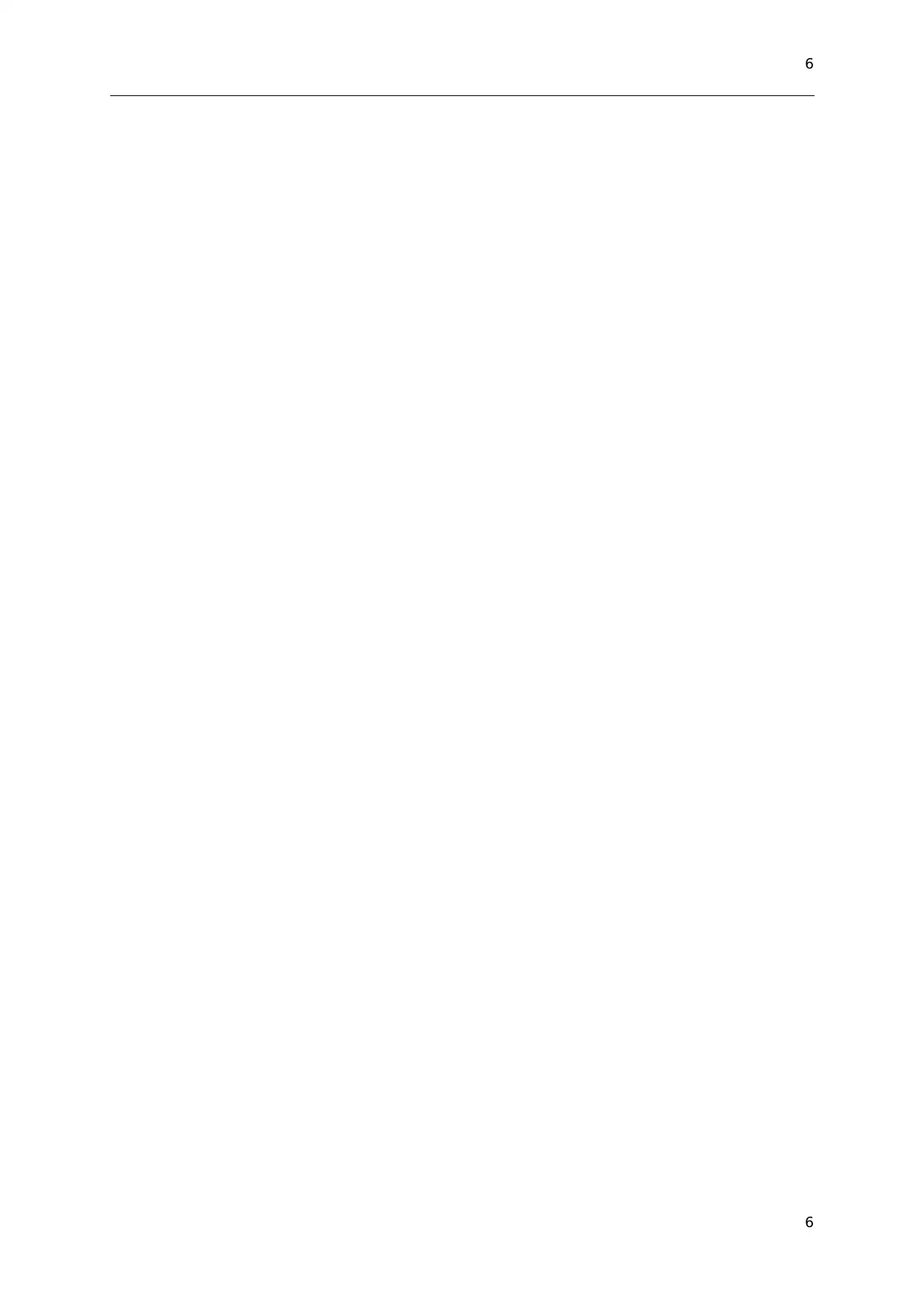
6
6
6
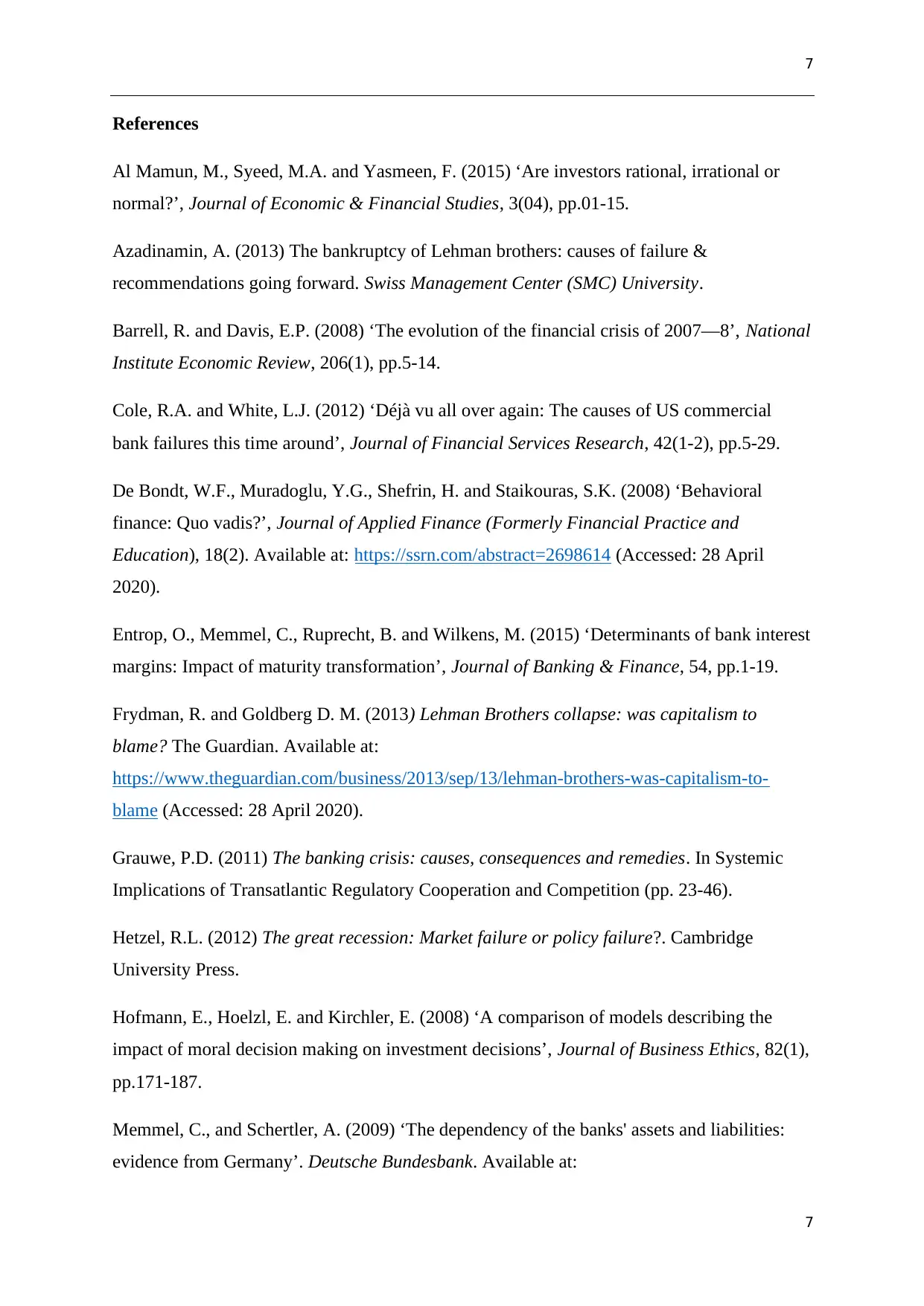
7
7
References
Al Mamun, M., Syeed, M.A. and Yasmeen, F. (2015) ‘Are investors rational, irrational or
normal?’, Journal of Economic & Financial Studies, 3(04), pp.01-15.
Azadinamin, A. (2013) The bankruptcy of Lehman brothers: causes of failure &
recommendations going forward. Swiss Management Center (SMC) University.
Barrell, R. and Davis, E.P. (2008) ‘The evolution of the financial crisis of 2007—8’, National
Institute Economic Review, 206(1), pp.5-14.
Cole, R.A. and White, L.J. (2012) ‘Déjà vu all over again: The causes of US commercial
bank failures this time around’, Journal of Financial Services Research, 42(1-2), pp.5-29.
De Bondt, W.F., Muradoglu, Y.G., Shefrin, H. and Staikouras, S.K. (2008) ‘Behavioral
finance: Quo vadis?’, Journal of Applied Finance (Formerly Financial Practice and
Education), 18(2). Available at: https://ssrn.com/abstract=2698614 (Accessed: 28 April
2020).
Entrop, O., Memmel, C., Ruprecht, B. and Wilkens, M. (2015) ‘Determinants of bank interest
margins: Impact of maturity transformation’, Journal of Banking & Finance, 54, pp.1-19.
Frydman, R. and Goldberg D. M. (2013) Lehman Brothers collapse: was capitalism to
blame? The Guardian. Available at:
https://www.theguardian.com/business/2013/sep/13/lehman-brothers-was-capitalism-to-
blame (Accessed: 28 April 2020).
Grauwe, P.D. (2011) The banking crisis: causes, consequences and remedies. In Systemic
Implications of Transatlantic Regulatory Cooperation and Competition (pp. 23-46).
Hetzel, R.L. (2012) The great recession: Market failure or policy failure?. Cambridge
University Press.
Hofmann, E., Hoelzl, E. and Kirchler, E. (2008) ‘A comparison of models describing the
impact of moral decision making on investment decisions’, Journal of Business Ethics, 82(1),
pp.171-187.
Memmel, C., and Schertler, A. (2009) ‘The dependency of the banks' assets and liabilities:
evidence from Germany’. Deutsche Bundesbank. Available at:
7
References
Al Mamun, M., Syeed, M.A. and Yasmeen, F. (2015) ‘Are investors rational, irrational or
normal?’, Journal of Economic & Financial Studies, 3(04), pp.01-15.
Azadinamin, A. (2013) The bankruptcy of Lehman brothers: causes of failure &
recommendations going forward. Swiss Management Center (SMC) University.
Barrell, R. and Davis, E.P. (2008) ‘The evolution of the financial crisis of 2007—8’, National
Institute Economic Review, 206(1), pp.5-14.
Cole, R.A. and White, L.J. (2012) ‘Déjà vu all over again: The causes of US commercial
bank failures this time around’, Journal of Financial Services Research, 42(1-2), pp.5-29.
De Bondt, W.F., Muradoglu, Y.G., Shefrin, H. and Staikouras, S.K. (2008) ‘Behavioral
finance: Quo vadis?’, Journal of Applied Finance (Formerly Financial Practice and
Education), 18(2). Available at: https://ssrn.com/abstract=2698614 (Accessed: 28 April
2020).
Entrop, O., Memmel, C., Ruprecht, B. and Wilkens, M. (2015) ‘Determinants of bank interest
margins: Impact of maturity transformation’, Journal of Banking & Finance, 54, pp.1-19.
Frydman, R. and Goldberg D. M. (2013) Lehman Brothers collapse: was capitalism to
blame? The Guardian. Available at:
https://www.theguardian.com/business/2013/sep/13/lehman-brothers-was-capitalism-to-
blame (Accessed: 28 April 2020).
Grauwe, P.D. (2011) The banking crisis: causes, consequences and remedies. In Systemic
Implications of Transatlantic Regulatory Cooperation and Competition (pp. 23-46).
Hetzel, R.L. (2012) The great recession: Market failure or policy failure?. Cambridge
University Press.
Hofmann, E., Hoelzl, E. and Kirchler, E. (2008) ‘A comparison of models describing the
impact of moral decision making on investment decisions’, Journal of Business Ethics, 82(1),
pp.171-187.
Memmel, C., and Schertler, A. (2009) ‘The dependency of the banks' assets and liabilities:
evidence from Germany’. Deutsche Bundesbank. Available at:
Paraphrase This Document
Need a fresh take? Get an instant paraphrase of this document with our AI Paraphraser
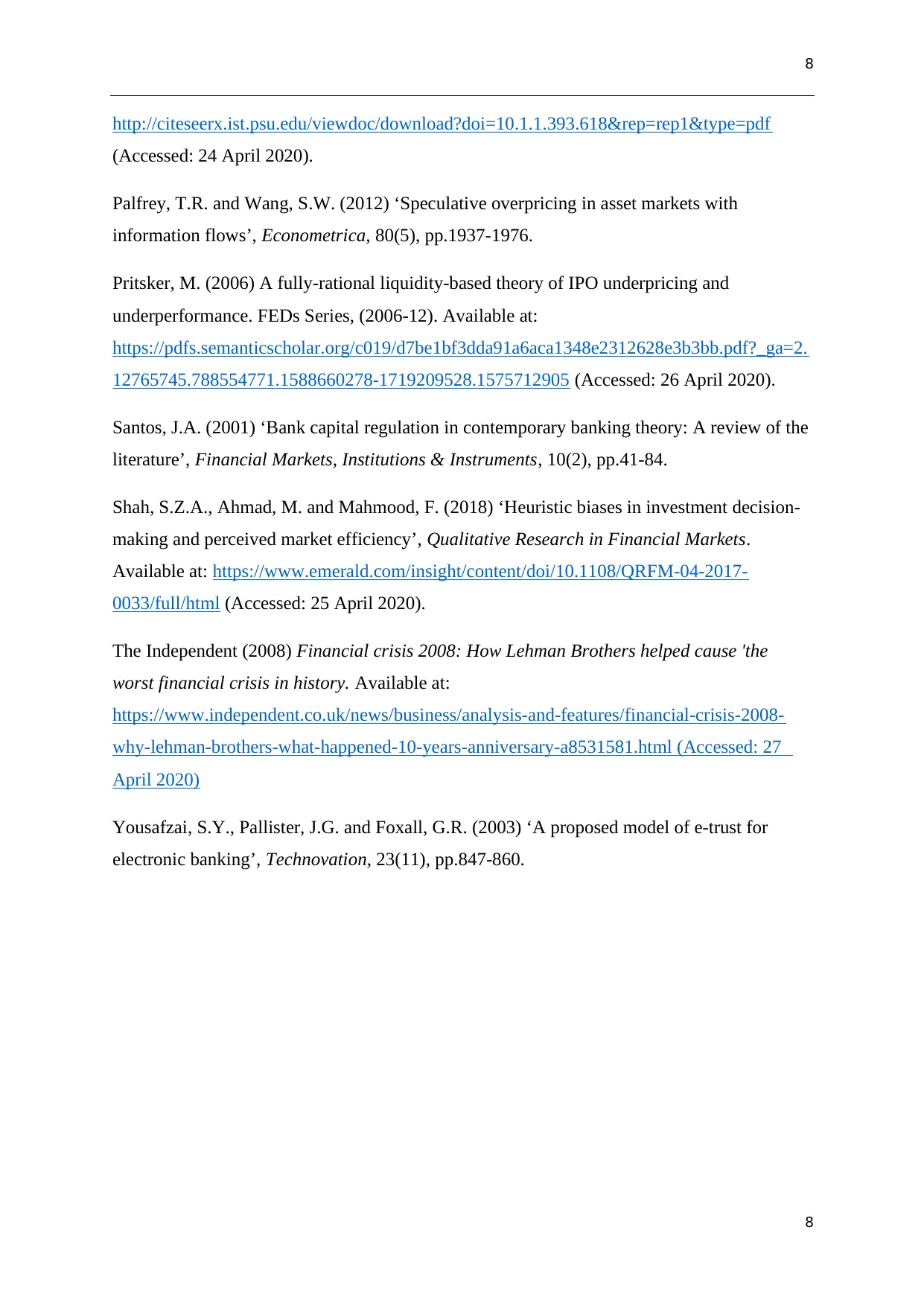
8
8
http://citeseerx.ist.psu.edu/viewdoc/download?doi=10.1.1.393.618&rep=rep1&type=pdf
(Accessed: 24 April 2020).
Palfrey, T.R. and Wang, S.W. (2012) ‘Speculative overpricing in asset markets with
information flows’, Econometrica, 80(5), pp.1937-1976.
Pritsker, M. (2006) A fully-rational liquidity-based theory of IPO underpricing and
underperformance. FEDs Series, (2006-12). Available at:
https://pdfs.semanticscholar.org/c019/d7be1bf3dda91a6aca1348e2312628e3b3bb.pdf?_ga=2.
12765745.788554771.1588660278-1719209528.1575712905 (Accessed: 26 April 2020).
Santos, J.A. (2001) ‘Bank capital regulation in contemporary banking theory: A review of the
literature’, Financial Markets, Institutions & Instruments, 10(2), pp.41-84.
Shah, S.Z.A., Ahmad, M. and Mahmood, F. (2018) ‘Heuristic biases in investment decision-
making and perceived market efficiency’, Qualitative Research in Financial Markets.
Available at: https://www.emerald.com/insight/content/doi/10.1108/QRFM-04-2017-
0033/full/html (Accessed: 25 April 2020).
The Independent (2008) Financial crisis 2008: How Lehman Brothers helped cause 'the
worst financial crisis in history. Available at:
https://www.independent.co.uk/news/business/analysis-and-features/financial-crisis-2008-
why-lehman-brothers-what-happened-10-years-anniversary-a8531581.html (Accessed: 27
April 2020)
Yousafzai, S.Y., Pallister, J.G. and Foxall, G.R. (2003) ‘A proposed model of e-trust for
electronic banking’, Technovation, 23(11), pp.847-860.
8
http://citeseerx.ist.psu.edu/viewdoc/download?doi=10.1.1.393.618&rep=rep1&type=pdf
(Accessed: 24 April 2020).
Palfrey, T.R. and Wang, S.W. (2012) ‘Speculative overpricing in asset markets with
information flows’, Econometrica, 80(5), pp.1937-1976.
Pritsker, M. (2006) A fully-rational liquidity-based theory of IPO underpricing and
underperformance. FEDs Series, (2006-12). Available at:
https://pdfs.semanticscholar.org/c019/d7be1bf3dda91a6aca1348e2312628e3b3bb.pdf?_ga=2.
12765745.788554771.1588660278-1719209528.1575712905 (Accessed: 26 April 2020).
Santos, J.A. (2001) ‘Bank capital regulation in contemporary banking theory: A review of the
literature’, Financial Markets, Institutions & Instruments, 10(2), pp.41-84.
Shah, S.Z.A., Ahmad, M. and Mahmood, F. (2018) ‘Heuristic biases in investment decision-
making and perceived market efficiency’, Qualitative Research in Financial Markets.
Available at: https://www.emerald.com/insight/content/doi/10.1108/QRFM-04-2017-
0033/full/html (Accessed: 25 April 2020).
The Independent (2008) Financial crisis 2008: How Lehman Brothers helped cause 'the
worst financial crisis in history. Available at:
https://www.independent.co.uk/news/business/analysis-and-features/financial-crisis-2008-
why-lehman-brothers-what-happened-10-years-anniversary-a8531581.html (Accessed: 27
April 2020)
Yousafzai, S.Y., Pallister, J.G. and Foxall, G.R. (2003) ‘A proposed model of e-trust for
electronic banking’, Technovation, 23(11), pp.847-860.
1 out of 8
Related Documents
Your All-in-One AI-Powered Toolkit for Academic Success.
+13062052269
info@desklib.com
Available 24*7 on WhatsApp / Email
![[object Object]](/_next/static/media/star-bottom.7253800d.svg)
Unlock your academic potential
© 2024 | Zucol Services PVT LTD | All rights reserved.





